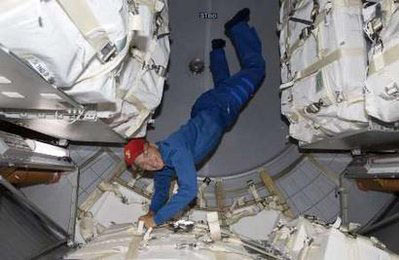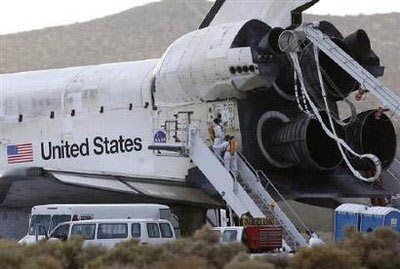Glowing waste water in the universe
Many amateur astronomers see streaks of light glistening in the sky on 9/9. At first they thought it was a mysterious astronomical event, but actually the light trail was only the astronauts' waste water in Discovery.
Many people in North America have seen light trails. Some people send pictures of it to the website called SpaceWeather.com.
Abe Megahed, a person living in Madison, Wisconsin, USA, took a streak of light at 9:40 pm on 9/9. He wrote: ' I was observing the shuttle and ISS when I saw a large and curved light trail. What could that be? Ship boosters? A comet? '.

Astronaut Rick Sturkow works on a non-qian international station on September 6.(Photo: Reuters)
According to Space, on September 8, Space Shuttle Discovery left the International Space Station (ISS) to prepare to return to Earth the next day. However, the flight was postponed because of the storm. Because there is no connection with the ISS, astronauts cannot bring waste water (including urine) to ISS for treatment as before. On September 10, pilot Kevin Ford was forced to throw urine and other waste water into the air.
According to NASA spokeswoman Kylie Clem, due to the amount of water Ford spilled in the space is too large (about 68 kg), people below ground can see light emitted from the water with a telescope.
' Astronauts are not allowed to dump waste water into the space when the shuttle is connecting to the ISS because that action could damage the Kibo laboratory ', Clem wrote in an e-mail for Space.

Astronaut Rick Sturkow works on a non-qian international station on September 6.(Photo: Reuters)
Kibo is a cosmological laboratory built by Japan for inclusion in ISS. It allows people to perform scientific experiments in space.
Clem affirmed that human beings on the planet saw waste water on the universe not a rare thing. When thrown off the ship, water turns into tiny ice crystals due to the relatively low temperature in the space. Then sunlight hits the ice crystals, reflecting light and turning into water vapor.
- 6 facts that make you change the way you think about using water
- New technology to treat industrial wastewater into clean water
- Generators from waste water
- New solution for waste in Vietnam
- Great discoveries about the universe are unknown (1)
- Launch missiles with waste water
- Clean water and numbers to speak
- Waste water treatment using anaerobic digestion technology
- Waste from bauxite ore can filter water?
- 10 reasons we have to save water and heartbreaking facts
- America develops technology to separate water from animal waste
- What is the problem with eating water spinach?
 Van Allen's belt and evidence that the Apollo 11 mission to the Moon was myth
Van Allen's belt and evidence that the Apollo 11 mission to the Moon was myth The levels of civilization in the universe (Kardashev scale)
The levels of civilization in the universe (Kardashev scale) Today Mars, the sun and the Earth are aligned
Today Mars, the sun and the Earth are aligned The Amazon owner announced a secret plan to build a space base for thousands of people
The Amazon owner announced a secret plan to build a space base for thousands of people